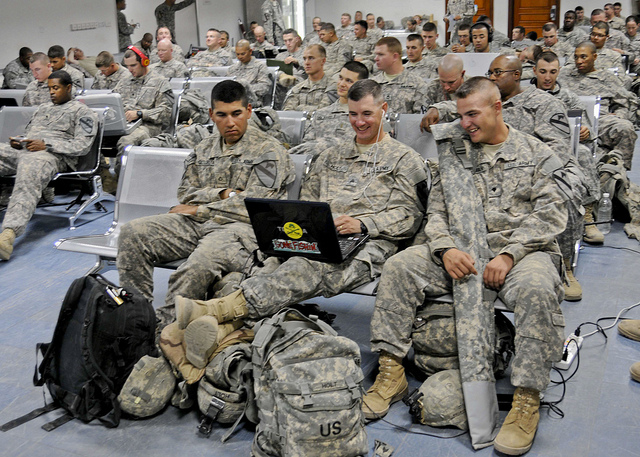Despite the drama, it looks like a done deal. John Kerry and Chuck Hagel will likely receive Senate confirmation for their new cabinet posts. Assuming there are no last minute challenges to their appointments, there is little to look forward to. A second term Obama Administration is unlikely to take any new risks in the Middle East.
Why complain about Hagel and Kerry, then? Because like Obama, they both support drawing down US military deployments abroad. Regarding Iran, while neither nominee advocates taking the “military option” off the table, Hagel and Kerry are far from the adventurists of the Bush era. Hagel, in particular, has been characterized as an “isolationist,” but that is a wild caricature of his views. What brings them together with the President is best described as a shared desire for disengagement.
The eight years of the Bush Administration and its War on Terror extended US military power to the breaking point. It brought few benefits, by any measure, for its enormous cost in blood and capital. That’s what Obama would like to recuperate, but it’s hardly a peace agenda. Rather, it is an attempt to revert US power back to what it was before Bush, when American influence could be extended by means other than prolonged military occupations, such as what’s taken place in Afghanistan, and of course Iraq.
Obama’s infatuation with the deadly drone program is a part of this disengagement. Drones require far less of a commitment of money, manpower and equipment than the ground forces favored by the neoconservatives. It allows Obama to pursue armed groups in remote places at a much lower cost and risk to the US and its soldiers. That the drones are routinely killing civilians and thus doing the same job of enflaming Muslim feelings against the United States, creating more of the same fanatical fighters we’re ostensibly trying to eliminate, demonstrates that the strategy is not about promoting peace and human rights. It’s about being able to continue waging war, at a lower cost. That is, to the United States, not our purported adversaries, obviously.
It has been discussed for some time that Obama has been working to shift the US focus toward Asia and away from the Middle East. There is no doubt that this is the direction Obama is pursuing, and it’s one that is fully supported by John Kerry and Chuck Hagel. But some have mistakenly discussed this in terms of abandoning the Middle East, or by arguing that the US would not be able to ignore the Middle East. One can hear the worry there, particularly for supporters of the current Israeli government.
This view stems from a short-term appreciation of American strategy. The United States has been entrenched in the Mideast for decades, and the reality of continuing dependence on the region’s oil resources has not changed. President Obama is not trying jump ship. Unfortunately, the enormous US military presence in the region has had a destabilizing effect, and that hasn’t escaped the White House, or US military leadership. Something smart needs to be done to preserve American hegemony.
So what does all of that mean for the Israel-centric views that have dominated US policy for so long? Despite the hostility towards the Kerry and Hagel nominations, it probably doesn’t bode ill for the increasingly right-wing Jewish state. Indeed, Israeli leaders could have simply stayed silent, but a number of them have supported Hagel, despite the neoconservative, AIPAC-orchestrated campaign against his appointment.
There is no indication that the Obama Administration is considering changing the most basic aspects of US support for Israel: $3 billion in annual aid, and a consistent veto at the UN Security Council. And a less involved US is something Benjamin Netanyahu’s neocon friends recommended to him years ago.
In their paper, A Clean Break: A New Strategy for Securing the Realm, a group of neocons outlined ways in which Israel, under Netanyahu, could change its relationship with the US in a manner that greatly reduced America’s ability to pressure Israel by reducing aid, eliminating loan guarantees, and “…stressing that Israel is self-reliant, does not need U.S. troops in any capacity to defend it, including on the Golan Heights, and can manage its own affairs. Such self-reliance will grant Israel greater freedom of action and remove a significant lever of pressure used against it in the past.”
This is certainly not what Obama and his new Cabinet are envisioning. However, it is very likely to be exactly what Bibi hopes he can engineer, if the White House continues to concern itself with other parts of the world.
It’s true that Hagel and Kerry are both critics of Israeli settlements, and are very likely to support something like the Clinton Parameters as a resolution of this issue. But there is no indication that the Obama II team is going to try to overcome the massive and unprecedented obstacles to a resolution that would actually be acceptable to the Palestinians and the rest of the Arab world.
Indeed, the dirty little secret among the more informed staffers and leaders on Capitol Hill is that the settlement expansion, especially in and around Jerusalem, coupled with Israel’s rightward shift, continued Palestinian fragmentation and a US Congress that is even more hawkish than the Netanyahu government, has created a situation where a negotiated settlement is completely impossible. Hence the significance of Obama’s disengagement option, which Bibi hopes he can benefit from.
Whether that neocon-Netanyahu vision will come to pass is far from a fait accompli. The US turn away from the Mideast is going to be a long process, far longer than Obama’s second term. Conditions on the ground can stall that turn, or even reverse it. Future Israeli leaders may be more worried than Netanyahu that a less involved United States might, at some future point, decide that its military aid and UN support are no longer in America’s best interest. Nevertheless, there can be little doubt that Netanyahu will embrace any reduction in US involvement in the region.
Photograph courtesy of United States Forces – Iraq (Inactive). Published under a Creative Commons license.





